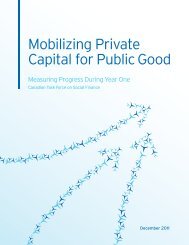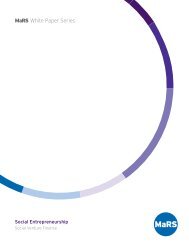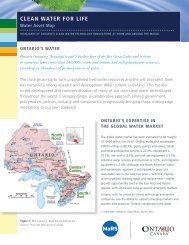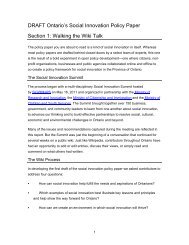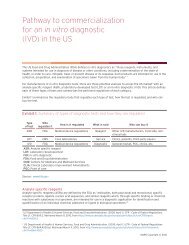Feed-in tariffs Accelerating renewable energy project development ...
Feed-in tariffs Accelerating renewable energy project development ...
Feed-in tariffs Accelerating renewable energy project development ...
Create successful ePaper yourself
Turn your PDF publications into a flip-book with our unique Google optimized e-Paper software.
Each source of capital has well-def<strong>in</strong>ed risk tolerances and<br />
return expectations. The higher the expected <strong>in</strong>ternal rate of<br />
return on the funds <strong>in</strong>vested, the higher the <strong>in</strong>herent risk of the<br />
<strong>in</strong>vestment. Renewable <strong>energy</strong> <strong>project</strong> risk is perceived by f<strong>in</strong>ancial<br />
<strong>in</strong>stitutions as primarily related to the risk of the <strong>renewable</strong><br />
<strong>energy</strong> technology employed, and execution risk on the part of the<br />
<strong>project</strong> developer. Key factors considered by potential <strong>renewable</strong><br />
<strong>energy</strong> <strong>project</strong> funders <strong>in</strong>clude the proposed size of the <strong>project</strong>, the<br />
creditworth<strong>in</strong>ess of the <strong>project</strong> developer, the proposed debt/equity<br />
ratio, the type and quality of any third-party contracts, and any<br />
regulatory or environmental concerns. ixxx<br />
Figure 7 compares return on <strong>in</strong>vestment expectations and risk factors<br />
across different fund<strong>in</strong>g sources for <strong>renewable</strong> <strong>energy</strong> <strong>project</strong>s.<br />
Canadian banks have yet to develop a significant presence <strong>in</strong> the<br />
<strong>renewable</strong> <strong>energy</strong> sector. The majority of Canada’s major FITsupported<br />
<strong>renewable</strong> <strong>energy</strong> <strong>project</strong>s have been f<strong>in</strong>anced with debt<br />
from German banks. Germany has had a FIT program of its own<br />
<strong>in</strong> place for nearly two decades, and German banks are leaders <strong>in</strong><br />
f<strong>in</strong>anc<strong>in</strong>g <strong>renewable</strong> <strong>energy</strong> <strong>project</strong>s around the world. Whereas<br />
Canadian banks still perceive <strong>renewable</strong> <strong>energy</strong> <strong>project</strong>s to be<br />
relatively high-risk endeavours, German banks have developed<br />
expertise <strong>in</strong> the sector and a comfort level with <strong>renewable</strong> <strong>energy</strong><br />
that far exceeds that of domestic f<strong>in</strong>anc<strong>in</strong>g <strong>in</strong>stitutions.<br />
In 2008, the f<strong>in</strong>anc<strong>in</strong>g of <strong>renewable</strong> <strong>energy</strong> assets accounted for the<br />
majority of new <strong>in</strong>vestment <strong>in</strong> green <strong>energy</strong>. A total of $136.1 billion<br />
Figure 8 New <strong>renewable</strong> <strong>energy</strong> asset f<strong>in</strong>anc<strong>in</strong>g by<br />
security type, 2002-2008 ($ US billions)<br />
6<br />
10<br />
2002 2003 2004 2005 2006 2007 2008<br />
Bond/other<br />
14<br />
Project f<strong>in</strong>ance<br />
28<br />
Balance sheet/syndicated equity<br />
50<br />
85<br />
97<br />
flowed to <strong>renewable</strong> <strong>energy</strong> assets <strong>in</strong> 2008, a 23% <strong>in</strong>crease over the<br />
previous year. lxxxii<br />
Figure 8 illustrates new <strong>renewable</strong> <strong>energy</strong> asset f<strong>in</strong>anc<strong>in</strong>g ($ US<br />
billions) from 2002 to 2008.<br />
Manag<strong>in</strong>g f<strong>in</strong>ancial risk <strong>in</strong> <strong>renewable</strong> <strong>energy</strong><br />
Renewable <strong>energy</strong> <strong>project</strong>s could not be brought about without an array<br />
of strategies designed to manage risk for lenders and equity <strong>in</strong>vestors.<br />
Project phas<strong>in</strong>g<br />
Renewable <strong>energy</strong> <strong>project</strong> developers generally structure their<br />
<strong>project</strong>s to be attractive to lenders and <strong>in</strong>vestors by organiz<strong>in</strong>g<br />
their f<strong>in</strong>anc<strong>in</strong>g process <strong>in</strong> two phases. The first phase, <strong>in</strong>volv<strong>in</strong>g<br />
sit<strong>in</strong>g, permitt<strong>in</strong>g and establish<strong>in</strong>g a FIT contract with the OPA,<br />
is generally self-funded. Dollars <strong>in</strong>vested early <strong>in</strong> the <strong>project</strong><br />
<strong>development</strong> process face the greatest measure of risk, because<br />
<strong>project</strong> abandonment is most likely at this stage. Once a <strong>project</strong> site<br />
has been secured, the <strong>energy</strong> resources verified, and the appropriate<br />
permits and power purchas<strong>in</strong>g agreements obta<strong>in</strong>ed, the risk of<br />
<strong>project</strong> abandonment decl<strong>in</strong>es. Hence a debt or equity arrangement<br />
is much more attractive for an external funder <strong>in</strong> the latter phase of<br />
the <strong>project</strong> <strong>development</strong> process.<br />
Expertise and diverse <strong>project</strong> portfolio<br />
One experienced <strong>project</strong> developer notes that a key risk management<br />
strategy employed by his company is to consistently make use of<br />
top-calibre eng<strong>in</strong>eers, attorneys and consultants, and to perform<br />
a great deal of due diligence early <strong>in</strong> the site selection process.<br />
Leverag<strong>in</strong>g the knowledge and track records of expert talent <strong>in</strong> the<br />
<strong>renewable</strong> <strong>energy</strong> sector helps to reassure lenders and <strong>in</strong>vestors that<br />
the execution risk for a <strong>renewable</strong> <strong>energy</strong> <strong>project</strong> will be held to a<br />
m<strong>in</strong>imum. This <strong>project</strong> developer also po<strong>in</strong>ts out that develop<strong>in</strong>g a<br />
number of <strong>project</strong>s simultaneously also mitigates the risk of any one<br />
<strong>project</strong> fail<strong>in</strong>g to reach the operational stage.<br />
Develop<strong>in</strong>g f<strong>in</strong>ancial <strong>in</strong>struments to manage<br />
risks <strong>in</strong> <strong>renewable</strong> <strong>energy</strong><br />
In order to foster <strong>renewable</strong> <strong>energy</strong> <strong>project</strong>s <strong>in</strong> Ontario, it will be<br />
necessary for the prov<strong>in</strong>ce’s f<strong>in</strong>ancial <strong>in</strong>stitutions and <strong>in</strong>surers to<br />
develop a strong base of expertise <strong>in</strong> the sector. An understand<strong>in</strong>g of<br />
the nature of the risks faced by <strong>renewable</strong> <strong>energy</strong> <strong>project</strong> developers<br />
is crucial, as is an abundance of technical knowledge and expertise<br />
<strong>in</strong> evaluat<strong>in</strong>g and modell<strong>in</strong>g historical weather data. In addition,<br />
<strong>in</strong>surers and f<strong>in</strong>ancial <strong>in</strong>stitutions must improve their ability to<br />
value <strong>renewable</strong> <strong>energy</strong> <strong>project</strong>s, particularly those that operate on a<br />
smaller scale. These <strong>project</strong>s are currently faced with extremely low<br />
<strong>in</strong>sured values, <strong>in</strong>creas<strong>in</strong>g the difficulty of obta<strong>in</strong><strong>in</strong>g f<strong>in</strong>anc<strong>in</strong>g. A f<strong>in</strong>al<br />
means of expand<strong>in</strong>g <strong>in</strong>surance options for <strong>renewable</strong> <strong>energy</strong> <strong>project</strong>s<br />
would be to allow foreign <strong>in</strong>surers greater access to the Ontario<br />
<strong>renewable</strong> <strong>energy</strong> market.<br />
The United Nations Environment Programme has compiled a<br />
list of f<strong>in</strong>ancial <strong>in</strong>struments commonly used to mitigate different<br />
<strong>renewable</strong> <strong>energy</strong> <strong>project</strong> risk factors. Figure 9 provides this<br />
<strong>in</strong>formation.<br />
Source Reproduced from Greenwood, Chris et al. (2009). Global<br />
Trends <strong>in</strong> Susta<strong>in</strong>able Energy Investment 2009: Analysis of<br />
Trends and Issues <strong>in</strong> the F<strong>in</strong>anc<strong>in</strong>g for Renewable Energy and<br />
Energy Efficiency. Pg. 36.<br />
Key actions and considerations for<br />
connect<strong>in</strong>g a microFIT <strong>project</strong> to the grid<br />
Secur<strong>in</strong>g a grid connection for a <strong>renewable</strong> <strong>energy</strong> <strong>project</strong> under<br />
15





